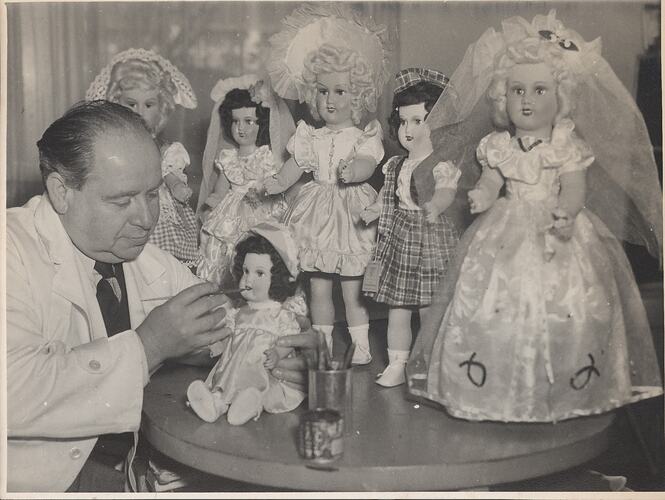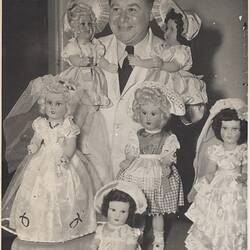Summary
Black and white photograph of Leo Sterne painting lips on one doll with a further five dolls manufactured by the L. J. Sterne Doll Company in the background.
This photograph relates to products and promotions of the L.J. Sterne Doll Company (1939-1971), a Melbourne doll and toy manufacturer founded by Austrian migrants Leo and Hilda Sterne.
Description of Content
Leo Sterne, holding a fine brush, is painting the lips of a dark haired doll seated upon a round table. A small tin of paint and container of painting tools sits to the dolls right, while a further five dolls stand towards the rear of the table. Furthest to the left, partially obscured by Leo Sterne is a blonde haired doll dressed in a lace trimmed bonnet and gingham dress with lace trimmed apron. Next stands a dark haired doll wearing a veil and wedding dress. In the middle stands a blonde haired doll wearing a large bonnet trimmed with tulle and a knee length dress with a collar. Next is a dark haired doll in a traditional Scottish costume of a shirt and vest with a skirt, beret and scarf made from check fabric. The doll furthest to the right is blonde haired wearing a veil and wedding dress.
Physical Description
Black and white photograph on paper.
Significance
This item is part of a growing collection of material relating to the migration and settlement experiences of Leo and Hilda Sterne who arrived in 1939. They immediately established a business that became one of the most successful doll and toy manufacturers in post-war Melbourne.
The L J Sterne Doll Company collection (1939-71) is significant as one of the few surviving collections related to an Australian toy and doll manufacturer, a once thriving industry in Australia. Only at the A. L Lindsay and Co. Archive at the Powerhouse Museum and the Jakas Toys Collection at Museum Victoria are comparable.
This collection of photographs, business and promotional documents, dolls, and toys enables the exploration of many historical and social themes including: local television and manufacturing industries; design and production innovation; marketing and merchandising; childhood; gender and cultural representations; leisure and sport; and key cultural and historical events.
More Information
-
Collection Names
-
Collecting Areas
-
Acquisition Information
Purchase
-
Place & Date Depicted
-
Person Depicted
-
Manufacturer of Item Depicted
L.J. Sterne Doll Co., Melbourne, Victoria, Australia, Oct 1953
-
Other Association (See Comments)
The Age Newspaper, Melbourne, Victoria, Australia, Oct 1953
Image published in The Age Oct 1953 -
Format
Photograph, 6" X 8", Black & White
-
Inscriptions
Written on back, in blue ink: 'The 'Age' / Oct. 1953'. Stamped on back, in purple ink: 'L. J. STERNE / DOLLS MANUFACTURERS / 14 HEDGELEY AVE. EAST MALVERN / PHONE U. L. 2150. S. E. 5. / MELBOURNE (VIC).'
-
Classification
-
Category
-
Discipline
-
Type of item
-
Image Dimensions - Photograph
208 mm (Width), 155 mm (Height)
-
Keywords
Toys, Dolls, Manufacturing, Painting & Decorating, Migrant Businesses, Austrian Immigration, German Immigration

